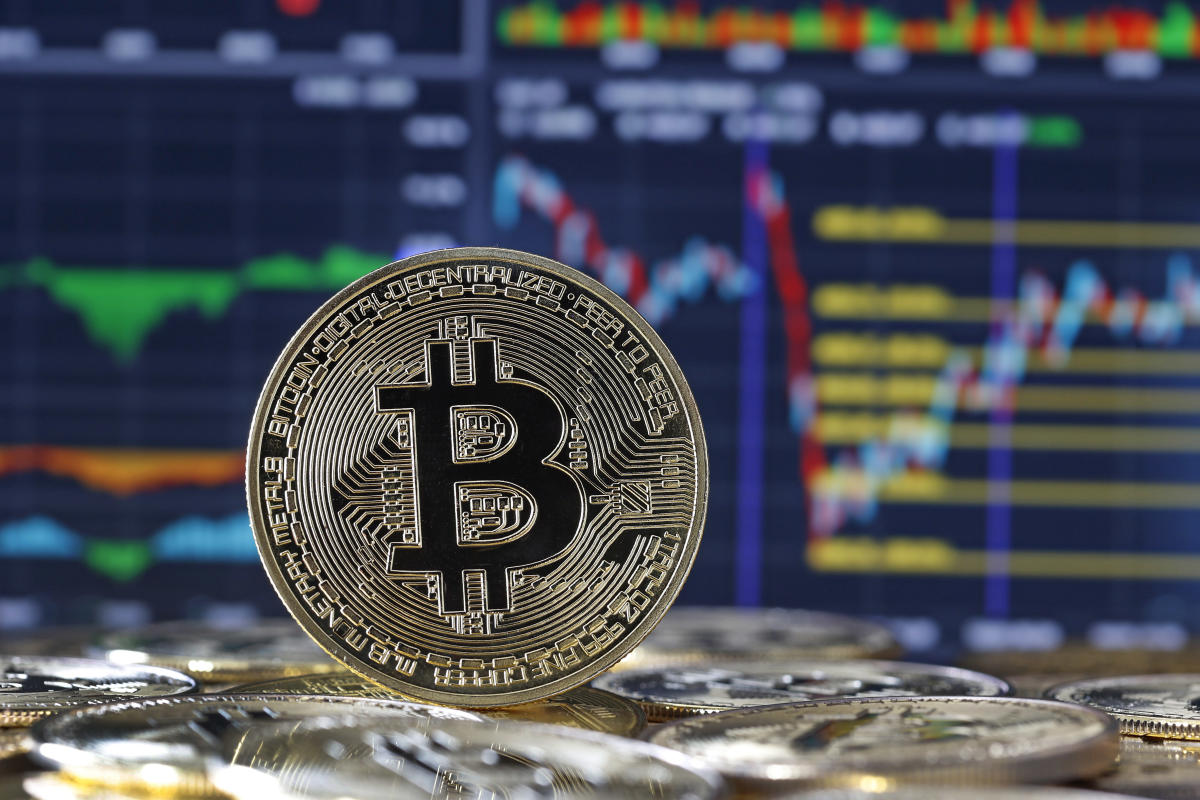News
The shadowy world of crypto

In an overnight assault earlier this month, Iran launched more than 300 drones and missiles against Israel. However, the aftershocks of this attack, codenamed ‘Operation True Promise’, were felt in a completely different universe.
Bitcoin, the most widely traded cryptocurrency, witnessed a ‘flash crash’ in trade, sliding from a record-high 70,000 to 60,000 dollars per Bitcoin. A slew of other cryptocurrencies, ranging from Solana to Ethereum and even the now hated, now loved Dogecoin, tanked. In one fell swoop, over 500 billion dollars were wiped off the combined crypto market.
Stunned? You shouldn’t be. Cryptocurrencies, touted as a potential way of democratising wealth, are the most vulnerable to sudden changes in the world — economic or geo-political.
I started researching the crypto scene in 2019, although its most remarkable bull run came in 2021. A large part of my journalistic career has been about studying, tracking and writing about financial assets like stocks, and I was drawn to understanding how much of a magnet crypto was for India’s youth. I was also intrigued by the sharp reactions it brought out in people, either of staunch support or intense hatred. Then, there was recurring news about crypto crime.
The research resulted in my book ‘Crypto Crimes — Inside India’s Best-Kept Secret’ (HarperCollins India), which hit the stands recently.
What is it?
Cryptocurrency acquires its name from the idea that it is ‘encrypted’. Think of it as a cross between a currency and a digital asset. You can use it to purchase things — from watches, cars, diamonds, yachts and space flight tickets to furniture, flowers, books, movie passes and coffee. Even crypto donations are a thing. You can invest it for long-term and most often short-term gains. The reason crypto sits parallel to the financial world is because it doesn’t rely on banks to verify transactions or involve payment processors for cross-border payments.
It is a peer-to-peer system in which transactions take place directly between the sender and the receiver over the Internet. In the same way a physical ledger or notebook is used to record money going in and out, an online database, called the blockchain, documents crypto payments.
Anyone who thinks crypto trading is a small or fringe activity is thoroughly mistaken. Data compiled by research firm CREBACO (Credit Rating for Exchanges Blockchains and Coin Offerings) is a case in point. As of November 2021, about 15 million Indians had invested in cryptocurrencies through Indian exchanges.
Awareness about crypto increased during the pandemic years. It also witnessed a jump in women participating in the crypto economy. I gathered that smaller cities like Giridih in Jharkhand, Gaya in Bihar and Karnal in Haryana were as crypto-savvy as the metros. But I was most surprised to learn that crypto coins, especially Bitcoin, had become a buzzword in parts of Gujarat all the way back in 2017.
There is no clear data on unemployment fuelling crypto investments but it appealed to the ‘tech-first’ generation, in the 22–30 age group.
‘When Lambo’ dreams
For many young people who don’t have enough resources to invest in the equity market, crypto trading involves small sums of investment and quick returns, like with a lottery ticket. Quite a few made a sudden killing. One trader from Jaipur used the profits to buy a sports bike, another, a documentary filmmaker from Delhi, bought a high-end phone and a camera, and a girl in Bengaluru said crypto was part of dinner-table conversations with family and they splurged the gains on vacations. ‘When Lambo?’ is often the goal. In crypto-speak, it means when are we getting rich enough to afford a Lamborghini?
I came across crypto seekers from all walks of life — from a journalist in Delhi to a businessman in Rajasthan to a reclusive man holed up in his apartment in Kerala. Some hailed from upwardly mobile families. In 2016, at the age of 21, Sapna Singh quit her IT job to become a crypto influencer on YouTube and now she is an author too. First you learn, then you remove the ‘l’, she writes in her book ‘The Basics of Crypto Market’. Some crypto investors switched from running call centres to operating ‘mining rigs’.
A mining rig is a computer system customised for cryptocurrency mining (mainly, validating transactions on the blockchain). Anytime a crypto coin is traded anywhere, these computers race to record and verify the transaction. The system that does it first earns most rewards and the time taken can vary from 10 to 300 minutes!
These calculations are energy-intensive. According to an analysis by Cambridge University, Bitcoin alone uses more electricity per year than the country of Argentina. Farmlands in north India, I found, had been cleverly converted into sites for mining rigs — power rates for agricultural use are low. South India had embraced solar rooftop power units to cut costs.
The rigs are expensive to assemble and markets like Nehru Place in Delhi and Bidhan Nagar in Kolkata are where mining enthusiasts go to collect cheap parts.
Not everybody was gung-ho about crypto. Prince is among the ‘invested sceptics’ I met. He said, “You are purchasing a f**king 64-digit code with no value. It can crash any time.” And Shaurya Sharma, a media professional, is unsure about its charm. When he is doing creative work, he gives it his 100% and the money follows, but the profits from crypto are not as satisfying. “It is easy money,” he explains.
Web of deceit
I didn’t buy crypto coins to get behind the scenes. Instead, I spent a lot of time as a quiet observer on WhatsApp and Telegram channels that sprang up, claiming to provide trading tips and ‘sureshot’ deals.
The chase for fast money was taking many wrong turns, I would discover. The year 2022 saw illicit crypto transactions worth 39.6 billion dollars, spanning cyber crime, ransomware and terror financing on the darknet. The crypto-romance scam, where a victim is befriended, seduced and financially exploited, is also rampant, as is illegal betting and looting crypto accounts at gunpoint to turn black
money into white.
I was keen not just on investigating the crypto crimes but also on giving space to the many voices who understood the complexity of this phenomenon. My curiosity took me to entrepreneurs who had built thriving crypto exchanges, influencers who chose to be paid in crypto to circumvent taxes and accountability, and people who had lost money to get-rich-quick schemes.

In early 2022, the Enforcement Directorate busted a fake cryptocurrency racket in Kerala, where about 900 investors had been cheated of Rs 1,200 crore. The scammers had floated an ‘initial coin offering’ to launch Morris Coin, a non-existent cryptocurrency on the Coimbatore-based Franc Exchange. The victims were lured on WhatsApp and YouTube and with promotional events featuring celebrities. They were promised daily returns of 3% on an investment of Rs 15,000. The accused, now arrested, had siphoned off the money to buy cars, crypto coins, and properties in Karnataka, Tamil Nadu and Kerala.
Drugs and data
Every interview showed a different side of aspiration and greed. The story of Bengaluru resident Sri Krishna Ramesh aka Sriki stands out. It was a sensational scam, involving the hacking of a crypto exchange, several gaming sites, and the Karnataka government’s e-procurement portal.
Arrested on drug peddling charges in 2020, the 20-something purportedly told the police he had blown up a fortune on living it up: “I did not save anything. I spent around Rs 1 lakh to Rs 3 lakh a day on alcohol and hotel bills.” A large part of his cat-and-mouse game with the police involved travelling through India and staying in five-star hotels in Shimla, Chandigarh, Delhi, Goa, Manipal and Bengaluru.
All my attempts to reach Sriki, out on bail, and his family failed. A senior policeman told me, “Sriki is a ghost. He has no phone, no ATM, no Aadhaar card, no coordinates.” It underscored the challenges that lie ahead for journalists like myself, but more importantly for investigating agencies, who by their own admission are trying to play catch-up with a network of financial criminals who have both technology and speed on their side.
What we know from Sriki’s claims is that he was gifted, born to a middle-class family in Andhra Pradesh. By Class 4, he had learnt coding and written a bot (a character controlled by the computer) for the popular video game RuneScape. He would hack his school’s attendance and marks portal to help his friends. He joined an online forum of blackhat (unethical) hackers, became its moderator and found mentors who taught him web exploitation. He turned to drugs, hacking, and cryptocurrency in college.
Using gig workers
Another scandal hit Karnataka two years later. ‘LSD King’ Raghunath Kumar was the alleged kingpin of this pan-India Bitcoin drug racket and ran it from a prison in Ballari. The cartel operated on the darknet, dealt in crypto to maintain anonymity, smuggled drugs into the country, used Telegram, Instagram, Snapchat and Wickr to get orders, and recruited Amazon, Swiggy and Zomato gig workers for delivery.
The Narcotics Control Bureau (NCB) arrested an MBBS student, a fashion designer, a psychiatrist, a YouTuber, and a financial analyst from a gang of 22 in the case. Later, school dropouts, musicians and bakers who had to shut their businesses during the Covid crisis were apprehended. Many had lived through troubled childhoods and some had started consuming drugs as teens, the reports said. The accused were granted bail.
While crypto plays out online, without intermediaries, the drugs make a conventional journey to reach the doorstep, relying on courier and postal services. That’s how Vyas aka Vikas, an unemployed B Tech dropout hailing from Thalassery in Kerala, came under suspicion. In 2022, a package from Poland arrived for him at the International Mail Centre of the postal department in Kochi. It contained 200 LSD stamps. The 35-year-old reportedly processed orders through the darknet and paid in crypto. He never stepped out from the first floor of his house, not even to interact with his own family. He stayed up all night and slept all day.
According to the NCB, Dipu Singh was India’s first narcotics vendor on the darknet to be caught. That was in 2020. A hotel management student from Lucknow, he was allegedly part of a global syndicate selling psychotropic drugs disguised as aphrodisiac pills and fitness supplements. He was brought into the syndicate by a man who offered him a job to deliver medicines online.
Peak exploitation
No other category of cryptocurrency-based crime has had a higher growth rate than ransomware. While 2020 will forever be known as the year of Covid, it is also the year when ransomware exploded — victims paid nearly 350 million dollars in cryptocurrency, over 300% increase from 2019.
The process moves this way. A criminal hacks into your computer and scrambles or messes up your files with unbreakable encryption so you are ‘locked’ out. He or she then demands that you pay for the encryption ‘key’ needed to unscramble the files. They bank on your willingness to pay a ransom to get your critical files back.
As I trace through the book, a string of large institutions in India have been victims of ransomware attacks — OIL India, SpiceJet, Uttar Haryana Bijli Vitran Nigam and AIIMS. The ransom was mostly demanded in crypto coins.
Policy divide
Regulating the crypto trade is a global challenge. The UAE, UK, Japan, and more recently, the USA have taken steps to introduce guardrails around it. But in countries like India, this remains a prickly subject.
Creating a policy around crypto comes with the implicit understanding that it is recognised as a financial asset, something many governments are shying away from doing. India has had a messier run with policy than others, swinging from a ban to reopening it and more recently introducing a hefty tax.
In India, cryptocurrency trades attract tax — 1% deducted at source (TDS), and 30% on capital gains, without any provision of offsetting the losses. This move, many small-time crypto traders told me, has ‘killed’ the domestic market.
A 2023 report shows that three to five million Indian users have chosen to shift to offshore platforms, moving 3.8 billion dollars of trading volume out of domestic exchanges. Part of the reason why crypto trading is so
volatile is because it is always ‘on’. It carries on 24 hours a day, every day. Many of the young crypto traders I spoke to were sleep-deprived because every minute is crucial. As Israel, Palestine and Iran conflicts demonstrate, anything can move money.
I also tried to unpack some questions through the course of my writing. The first, is crypto really enemy number one for lawmakers and law enforcers? Two sets of conversations have stayed with me. Crypto entrepreneurs see this as a game-changer for those that do not have the privilege of inter-generational wealth — for some, it is their only livelihood. Law enforcers are frustrated by the speed at which fraudsters are outsmarting them, selling ammunition and even identities, and kidnapping for crypto ransom. Their training is rudimentary — it is like trying to fix a Ferrari with a bicycle wrench.
It is not that solutions have not been proposed. In April 2022, India’s Bureau of Police Research Development issued guidelines on how to investigate crypto crimes. It was suggested law enforcers own crypto wallets to store seized virtual digital assets, and be in constant communication with crypto exchanges to block a suspect’s wallet or reset the keys to defuse transactions. But it is the breadcrumb trail they struggle with — tracing transactions and the suspects.
Looking away cannot be the answer to India’s crypto conundrum. Not when 4,000 pin codes are trading in crypto because there is no language barrier to pick up the skill, when college graduates are ditching 9-to-5 jobs for a career in crypto, and when it has become part of pop culture.
The three key protagonists — the Reserve Bank of India, Securities and Exchange Board of India, and the government — have at different times held divergent views on cryptocurrency. Often, policy decisions have had a pendulum-like feel to them, with crypto alternately moving from being ‘good’ to ‘very bad’. These binaries cannot and do not exist. We have to clear up the confusion. Our policy will have to be nimble, allowing for talent to experiment with new tech while we weed out the malpractices.
Like this story? Email: dhonsat@deccanherald.co.in
Published 03 May 2024, 20:17 IST
News
Bitcoin soars above $63,000 as money flows into new US investment products

Bitcoin has surpassed the $63,000 mark for the first time since November 2021. (Chesnot via Getty Images)
Bitcoin has broken above the $63,000 (£49,745) mark for the first time since November 2021, when the digital asset hit its all-time high of over $68,000.
Over the past 24 hours, the value of the largest digital asset by market capitalization has increased by more than 8% to trade at $63,108, at the time of writing.
Learn more: Live Cryptocurrency Prices
The price appreciation was fueled by record inflows into several U.S.-based bitcoin cash exchange-traded funds (ETFs), which were approved in January this year.
A Bitcoin spot ETF is a financial product that investors believe will pave the way for an influx of traditional capital into the cryptocurrency market. Currently, indications are favorable, with fund managers such as BlackRock (BLK) and Franklin Templeton (BEN), after allocating a record $673 million into spot Bitcoin ETFs on Wednesday.
Learn more: Bitcoin’s Success With SEC Fuels Expectations for an Ether Spot ETF
The record allocation surpassed the funds’ first day of launch, when inflows totaled $655 million. BlackRock’s iShares Bitcoin Trust ETF (I BITE) alone attracted a record $612 million yesterday.
Bitcoin Price Prediction
Earlier this week, veteran investor Peter Brandt said that bitcoin could peak at $200,000 by September 2025. “With the push above the upper boundary of the 15-month channel, the target for the current market bull cycle, which is expected to end in August/September 2025, is raised from $120,000 to $200,000,” Brandt said. published on X.
The influx of capital from the traditional financial sphere into Bitcoin spot ETFs is acting as a major price catalyst for the digital asset, but it is not the only one. The consensus among analysts is that the upcoming “bitcoin halving” could continue to drive flows into the bitcoin market.
The Bitcoin halving is an event that occurs roughly every four years and is expected to happen again next April. The halving will reduce the bitcoin reward that miners receive for validating blocks on the blockchain from 6.25 BTC to 3.125 BTC. This could lead to a supply crunch for the digital asset, which could lead to price appreciation.
The story continues
Watch: Bitcoin ETFs set to attract funds from US pension plans, says Standard Chartered analyst | Future Focus
Download the Yahoo Finance app, available for Apple And Android.
News
FRA Strengthens Cryptocurrency Practice with New Director Thomas Hyun

Forensic Risk Alliance (FRA), an independent consultancy specializing in regulatory investigations, compliance and litigation, has welcomed U.S.-based cryptocurrency specialist Thomas Hyun as a director of the firm’s global cryptocurrency investigations and compliance practice. Hyun brings to the firm years of experience building and leading anti-money laundering (AML) compliance programs, including emerging payment technologies in the blockchain and digital asset ecosystem.
Hyun has nearly 15 years of experience as a compliance officer. Prior to joining FRA, he served as Director of AML and Blockchain Strategy at PayPal for four years. He established PayPal’s financial crime policy and control framework for its cryptocurrency-related products, including PayPal’s first consumer-facing cryptocurrency offering on PayPal and Venmo, as well as PayPal’s branded stablecoin.
At PayPal, Hyun oversaw the second-line AML program for the cryptocurrency business. His responsibilities included drafting financial crime policies supporting the cryptocurrency business, establishing governance and escalation processes for high-risk partners, providing credible challenge and oversight of front-line program areas, and reporting to the Board and associated authorized committees on program performance.
Prior to joining PayPal, Hyun served as Chief Compliance Officer and Bank Secrecy Officer (BSA) at Paxos, a global blockchain infrastructure company. At Paxos, he was responsible for implementing the compliance program, including anti-money laundering and sanctions, around the company’s digital asset exchange and its asset-backed tokens and stablecoins. He also supported the company’s regulatory engagement efforts, securing regulatory approvals, supporting regulatory reviews, and ensuring compliance with relevant digital asset requirements and guidelines.
Thomas brings additional experience in payments and financial crime compliance (FCC), having previously served as Vice President of Compliance at Mastercard, where he was responsible for compliance for its consumer products portfolio. He also spent more than seven years in EY’s forensics practice, working on various FCC investigations for U.S. and foreign financial institutions.
Hyun is a Certified Anti-Money Laundering Specialist (CAMS) and a Certified Fraud Examiner (CFE). He is a graduate of New York University’s Stern School of Business, where he earned a bachelor’s degree in finance and accounting. Additionally, he serves on the board of directors for the Central Ohio Association of Certified Anti-Money Laundering Specialists (ACAMS) chapter.
Commenting on his appointment, Hyun said, “With my experience overseeing and implementing effective compliance programs at various levels of maturity and growth, whether in a startup environment or large enterprises, I am excited to help our clients overcome similar obstacles and challenges to improve their financial crime compliance programs. I am excited to join FRA and leverage my experience to help clients navigate the complexities of AML compliance and financial crime prevention in this dynamic space.”
FRA Partner, Roy Pollittadded: “As the FRA’s sponsor partner for our growing Cryptocurrency Investigations and Compliance practice, I am thrilled to have Thomas join our ever-expanding team. The rapid evolution of blockchain and digital asset technologies presents both exciting opportunities and significant compliance challenges. Hiring Thomas in a leadership role underscores our commitment to staying at the forefront of the industry by enhancing our expertise in anti-money laundering and blockchain strategy.”
“Thomas’ extensive background in financial crime compliance and proven track record of building risk-based FCC programs in the blockchain and digital asset space will be invaluable as we continue to provide our clients with the highest level of service and innovative solutions.”
“FRA strengthens cryptocurrency practice with new director Thomas Hyun” was originally created and published by International Accounting Bulletina brand owned by GlobalData.
The information on this website has been included in good faith for general information purposes only. It is not intended to amount to advice on which you should rely, and we make no representations, warranties or assurances, express or implied, as to its accuracy or completeness. You must obtain professional or specialist advice before taking, or refraining from, any action on the basis of the content on our website.
News
Bitcoin trades around $57,000, crypto market drops 6% ahead of Fed decision

-
Bitcoin fell in line with the broader cryptocurrency market, with ether and other altcoins also falling.
-
Financial markets were weighed down by risk-off sentiment ahead of the Fed’s interest rate decision and press conference later in the day.
-
10x Research said it is targeting a price target of $52,000 to $55,000, anticipating further selling pressure.
Bitcoin {{BTC}} was trading around $57,700 during European morning trading on Wednesday after falling to its lowest level since late February, as the world’s largest cryptocurrency recorded its worst month since November 2022.
BTC has fallen about 6.3% over the past 24 hours, after breaking below the $60,000 support level late Tuesday, according to data from CoinDesk. The broader crypto market, as measured by the CoinDesk 20 Index (CD20), lost nearly 9% before recovering part of its decline.
Cryptocurrencies have been hurt by risk-off sentiment in broader financial markets amid stagflation in the United States, following indications of slowing growth and persistent inflation that have dampened hopes of an interest rate cut by the Federal Reserve. The Federal Open Market Committee is due to deliver its latest rate decision later in the day.
Ether {{ETH}} fell about 5%, dropping below $3,000, while dogecoin {{DOGE}} led the decline among other major altcoins with a 9% drop. Solana {{SOL}} and Avalanche {{AVAX}} both lost about 6%.
Bitcoin plunged in April, posting its first monthly loss since August. The 16% drop is the worst since November 2022, when cryptocurrency exchange FTX imploded, but some analysts are warning of further declines in the immediate future.
10x Research, a digital asset research firm, said it sees selling pressure toward the $52,000 level due to outflows from U.S. cash exchange-traded funds, which have totaled $540 million since the Bitcoin halving on April 20. It estimates that the average entry price for U.S. Bitcoin ETF holders is $57,300, so this could prove to be a key support level.
The closer the bitcoin spot price is to this average entry price, the greater the likelihood of a new ETF unwind, 10x CEO Markus Thielen wrote Wednesday.
“There may have been a lot of ‘TradeFi’ tourists in crypto – pushing longs all the way to the halving – that period is now over,” he wrote. “We expect more unwinding as the average Bitcoin ETF buyer will be underwater when Bitcoin trades below $57,300. This will likely push prices down to our target levels and cause a -25% to -29% correction from the $73,000 high – hence our $52,000/$55,000 price target over the past three weeks.”
The story continues
UPDATE (May 1, 8:56 UTC): Price updates throughout the process.
UPDATE (May 1, 9:57 UTC): Price updates throughout the process.
UPDATE (May 1, 11:05 UTC): Adds analysis from 10x.
News
The Cryptocurrency Industry Is Getting Back on Its Feet, for Better or Worse

Hello from Austin, where thousands of crypto enthusiasts braved storms and scorching heat to attend Consensus. The industry’s largest and longest-running conference, which can sometimes feel like a religious revival, offers opportunities to chat and listen to leading names in crypto. And for the casual observer, Consensus offers a useful glimpse into the mood of an industry prone to wild swings in fortune.
Unsurprisingly, the mood is noticeably more positive than it was a year ago, when crowds were sparse and many attendees were quietly confiding that they were considering switching to AI. In practice, that means some of the more obnoxious elements are back, but not to the level of Consensus 2018 in New York, when charlatans parked Lamborghinis outside the event and the hallways were lined with booth girls and scammers pitching “ICOs in a box.”
This time around, Elon Musk’s Cybertrucks have replaced Lamborghinis as the vehicle of choice for marketers. One of the most notable publicity stunts was a startup that paid a poor guy to parade around in the Texas sun in a Jamie Dimon costume, wig, and mask, and then staged a mock assault on him by memecoin characters.
Outside the event was a giant “RFK for President” truck, while campaign staffers manned a booth instead — a reflection of both the election year and crypto’s willingness to latch onto any candidate, no matter how outlandish, who will talk about the industry. RFK himself is scheduled to address the conference on Thursday.
Excesses aside, the general sense of optimism was understandable. The cryptocurrency market has not only recovered from the wave of fraud that nearly sank it in 2022, it is riding a new wave of political legitimacy. This month, cryptocurrencies scored once-unthinkable political victories in Washington, D.C., and there is a sense that the industry has not only withstood the relentless regulatory assaults of SEC Chairman Gary Gensler and Sen. Elizabeth Warren, but is poised to defeat them.
And while cryptocurrency is still searching for its flagship application, the optimists I spoke with pointed to signs that it is (once again) upon us. Those signs include the rapid advancement of zero-knowledge proofs as well as the popularity of Coinbase’s Base blockchain and, perhaps most importantly, the large-scale arrival of traditional finance into the world of cryptocurrencies – a development that not only provides a major financial boost, but also a new element of stability and maturity that will, perhaps, tame the worst of crypto’s wilder side. Finally, this consensus marked the end of the Austin era as the conference, under new leadership, will be held in Toronto and Hong Kong in 2025.
The story continues
Jeff John Roberts
jeff.roberts@fortune.com
@jeffjohnroberts
This story was originally featured on Fortune.com
-

 News11 months ago
News11 months agoBitcoin soars above $63,000 as money flows into new US investment products
-

 DeFi11 months ago
DeFi11 months agoEthena downplays danger of letting traders use USDe to back risky bets – DL News
-

 News11 months ago
News11 months agoFRA Strengthens Cryptocurrency Practice with New Director Thomas Hyun
-

 DeFi11 months ago
DeFi11 months agoZodialtd.com to revolutionize derivatives trading with WEB3 technology
-

 Markets11 months ago
Markets11 months agoBitcoin Fails to Recover from Dovish FOMC Meeting: Why?
-

 DeFi1 year ago
DeFi1 year ago👀 Lido prepares its response to the recovery boom
-

 DeFi1 year ago
DeFi1 year agoPancakeSwap integrates Zyfi for transparent, gas-free DeFi
-

 DeFi1 year ago
DeFi1 year ago🏴☠️ Pump.Fun operated by Insider Exploit
-

 Markets1 year ago
Markets1 year agoa resilient industry that defies market turbulence
-

 DeFi1 year ago
DeFi1 year ago👀SEC Receives Updated Spot Ether ETF Filings
-

 DeFi1 year ago
DeFi1 year ago🚀 S&P says tokenization is the future
-

 DeFi1 year ago
DeFi1 year ago⏱️ The SEC is not rushing the commercialization of Spot Ether ETFs












